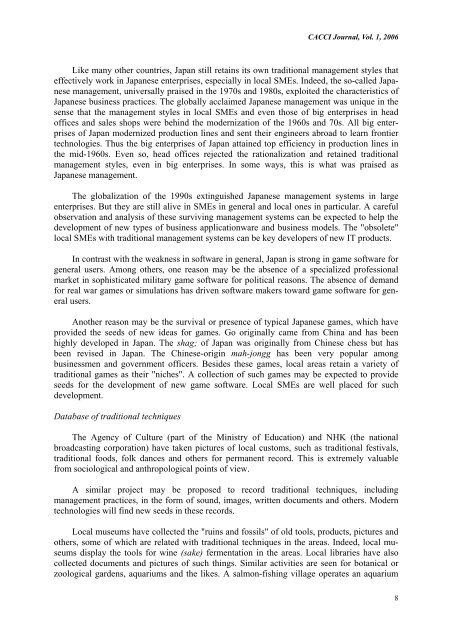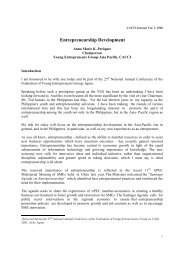The Importance of Traditional Techniques - cacci
The Importance of Traditional Techniques - cacci
The Importance of Traditional Techniques - cacci
You also want an ePaper? Increase the reach of your titles
YUMPU automatically turns print PDFs into web optimized ePapers that Google loves.
CACCI Journal, Vol. 1, 2006Like many other countries, Japan still retains its own traditional management styles thateffectively work in Japanese enterprises, especially in local SMEs. Indeed, the so-called Japanesemanagement, universally praised in the 1970s and 1980s, exploited the characteristics <strong>of</strong>Japanese business practices. <strong>The</strong> globally acclaimed Japanese management was unique in thesense that the management styles in local SMEs and even those <strong>of</strong> big enterprises in head<strong>of</strong>fices and sales shops were behind the modernization <strong>of</strong> the 1960s and 70s. All big enterprises<strong>of</strong> Japan modernized production lines and sent their engineers abroad to learn frontiertechnologies. Thus the big enterprises <strong>of</strong> Japan attained top efficiency in production lines inthe mid-1960s. Even so, head <strong>of</strong>fices rejected the rationalization and retained traditionalmanagement styles, even in big enterprises. In some ways, this is what was praised asJapanese management.<strong>The</strong> globalization <strong>of</strong> the 1990s extinguished Japanese management systems in largeenterprises. But they are still alive in SMEs in general and local ones in particular. A carefulobservation and analysis <strong>of</strong> these surviving management systems can be expected to help thedevelopment <strong>of</strong> new types <strong>of</strong> business applicationware and business models. <strong>The</strong> "obsolete"local SMEs with traditional management systems can be key developers <strong>of</strong> new IT products.In contrast with the weakness in s<strong>of</strong>tware in general, Japan is strong in game s<strong>of</strong>tware forgeneral users. Among others, one reason may be the absence <strong>of</strong> a specialized pr<strong>of</strong>essionalmarket in sophisticated military game s<strong>of</strong>tware for political reasons. <strong>The</strong> absence <strong>of</strong> demandfor real war games or simulations has driven s<strong>of</strong>tware makers toward game s<strong>of</strong>tware for generalusers.Another reason may be the survival or presence <strong>of</strong> typical Japanese games, which haveprovided the seeds <strong>of</strong> new ideas for games. Go originally came from China and has beenhighly developed in Japan. <strong>The</strong> shag; <strong>of</strong> Japan was originally from Chinese chess but hasbeen revised in Japan. <strong>The</strong> Chinese-origin mah-jongg has been very popular amongbusinessmen and government <strong>of</strong>ficers. Besides these games, local areas retain a variety <strong>of</strong>traditional games as their "niches". A collection <strong>of</strong> such games may be expected to provideseeds for the development <strong>of</strong> new game s<strong>of</strong>tware. Local SMEs are well placed for suchdevelopment.Database <strong>of</strong> traditional techniques<strong>The</strong> Agency <strong>of</strong> Culture (part <strong>of</strong> the Ministry <strong>of</strong> Education) and NHK (the nationalbroadcasting corporation) have taken pictures <strong>of</strong> local customs, such as traditional festivals,traditional foods, folk dances and others for permanent record. This is extremely valuablefrom sociological and anthropological points <strong>of</strong> view.A similar project may be proposed to record traditional techniques, includingmanagement practices, in the form <strong>of</strong> sound, images, written documents and others. Moderntechnologies will find new seeds in these records.Local museums have collected the "ruins and fossils" <strong>of</strong> old tools, products, pictures andothers, some <strong>of</strong> which are related with traditional techniques in the areas. Indeed, local museumsdisplay the tools for wine (sake) fermentation in the areas. Local libraries have alsocollected documents and pictures <strong>of</strong> such things. Similar activities are seen for botanical orzoological gardens, aquariums and the likes. A salmon-fishing village operates an aquarium8
















